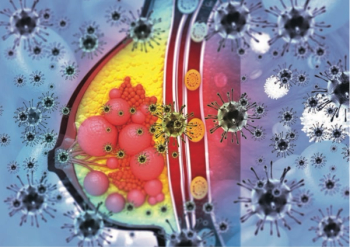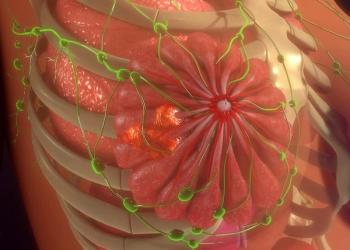
- ONCOLOGY Vol 16 No 6
- Volume 16
- Issue 6
FDA Approves New Treatment for Tamoxifen-Resistant Breast Cancer
The US Food and Drug Administration (FDA) has granted approval to AstraZeneca’s new breast cancer drug fulvestrant (Faslodex) for treatment of hormone-receptor-positive metastatic breast cancer in postmenopausal women with disease progression following antiestrogen therapy, with, for example, tamoxifen. Fulvestrant is an estrogen-receptor antagonist without known agonist effects. It is the only estrogen-receptor antagonist to be proven effective after tamoxifen failure.
The US Food and Drug Administration(FDA) has granted approval to AstraZeneca’s new breast cancer drugfulvestrant (Faslodex) for treatment of hormone-receptor-positive metastaticbreast cancer in postmenopausal women with disease progression followingantiestrogen therapy, with, for example, tamoxifen. Fulvestrant is anestrogen-receptor antagonist without known agonist effects. It is the onlyestrogen-receptor antagonist to be proven effective after tamoxifen failure.
Distinct Hormonal Therapy
Currently, advanced breast cancer patients whose tumors havebeen shown to depend on hormones to grow may be given drugs such as tamoxifenthat act by blocking the estrogen receptor, or aromatase inhibitors thatdecrease the amount of estrogen in a woman’s body. Fulvestrant is a hormonaltherapy that works by binding, blocking, and degrading the estrogen receptor,and does not cause the type of side effects commonly associated with cytotoxicchemotherapy. It is administered as a once-monthly intramuscular injection,which may assist health-care professionals in monitoring compliance, and mayalso make treatment more convenient for some patients.
"Faslodex provides an effective, new treatment optionfor women with advanced breast cancer whose tumors have become resistant totamoxifen," said lead fulvestrant trial investigator C. Kent Osborne, MD,Baylor College of Medicine, Houston. "When you have a new drug likeFaslodex that we can now add to that sequence of drugs, we may be able tocontrol the breast cancer for a longer period of time."
Gerard T. Kennealey, MD, vice president of clinical research,oncology, for AstraZeneca, noted, "The management of advanced breast cancerhas significantly improved through sequential treatment with different hormonaltherapies. The introduction of Faslodex expands the number of options availablefor sequential treatment and provides women with a new drug that works in adifferent way."
Phase III Trials Confirm Activity
The FDA approval was based on data from two phase III,randomized, multicenter studies (one in North America and one predominantly inEurope) comparing fulvestrant, 250 mg once monthly injection, to daily 1-mg oralanastrozole (Arimidex) tablets. The total of 851 women enrolled in both trialswere postmenopausal with a variety of involved sites (including liver and lung)and had been treated with one prior hormonal therapyin almost all cases,tamoxifen.
The effectiveness of fulvestrant was established bycomparison to the selective aromatase inhibitor anastrozole, as measured byobjective response rate and time to progression. The objective response rate inthe North American trial was 17% with fulvestrant vs 17% with anastrozole, andin the European trial, 20% with fulvestrant vs 15% with anastrozole. Thereported time to progression for fulvestrant vs anastrozole was 5.5 vs 3.5months in the North American trial, and 5.5 vs 5.2 months in the European trial.
Fulvestrant can cause fetal harm when administered to apregnant woman. Women of childbearing potential should be advised not to becomepregnant while receiving fulvestrant.
Adverse Reactions Noted
The most commonly reported adverse events seen with fulvestrant vsanastrozole treatment, regardless of the investigator’s assessment ofcausality, were gastrointestinal symptoms (nausea, 26.0% vs 25.3%; vomiting,13.0% vs 11.8%; constipation, 12.5% vs 10.6%; diarrhea, 12.3% vs 12.8%;abdominal pain, 11.8% vs 11.6%), headache (15.4% vs 16.8%), back pain (14.4% vs13.2%), hot flushes (17.7% vs 17.3%), and pharyngitis (16.1% vs 11.6%).Injection site reactions of mild, transient pain and inflammation were reportedin 7% of patients (1% of treatments) given single 5-mL injections and 27% ofpatients (4.6% of treatments) given 2 × 2.5-mL injections of fulvestrant.
Articles in this issue
over 23 years ago
Cutting-Edge PET/CT Scanner Is Clinically Operationalover 23 years ago
Textbook of Lung Cancerover 23 years ago
Screening Agent Helps Detect Prostate Cancer Recurrence Earlierover 23 years ago
Oncology Care Included in Medicare Disease Management Demonstrationsover 23 years ago
Liquid Pamidronate Disodium Injection Approvedover 23 years ago
Medical Liability Reform ResurrectedNewsletter
Stay up to date on recent advances in the multidisciplinary approach to cancer.

















































































